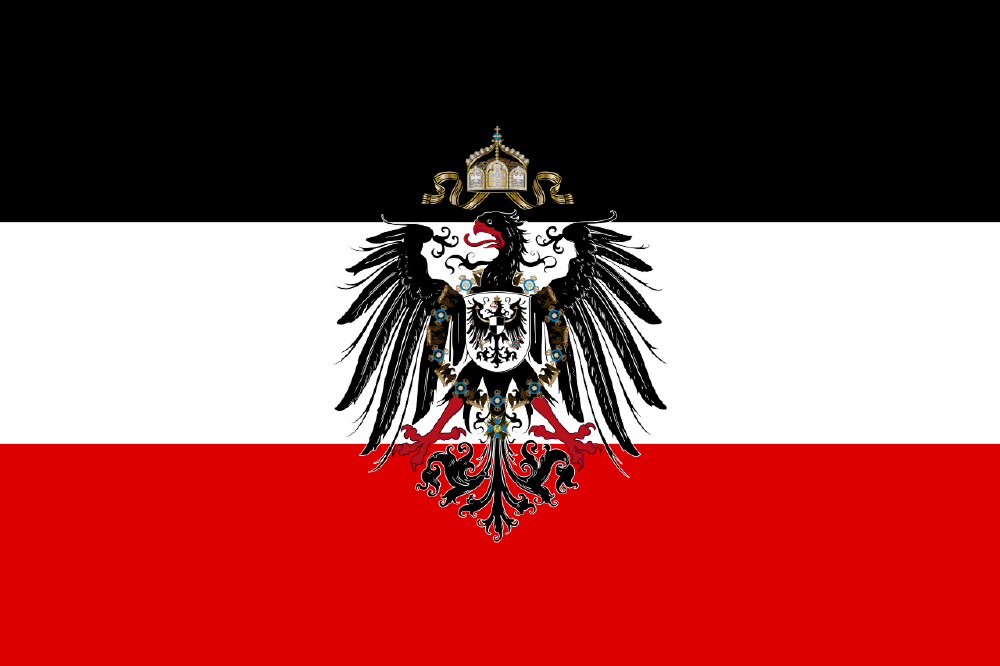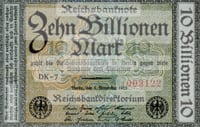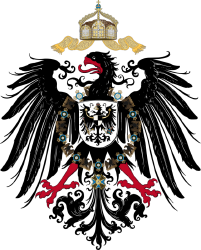| National Factbook |
| Flag: |

|
| Nation Name: |
Imperial Germany II |
| Leader Name: |
Wilhelm Il |
| Currency: |

Papiermark |
| National Animal: |

Imperial Eagle |
| History: |
The German Confederation had been created by an act of the Congress of Vienna on 8 June 1815 as a result of the Napoleonic Wars, after being alluded to in Article 6 of the 1814 Treaty of Paris.
The liberal Revolutions of 1848 were crushed after the relations between the educated, well-off middle-class liberals and the urban artisans broke down; Otto von Bismarck's pragmatic Realpolitik, which appealed to peasants as well as the aristocracy, took its place. Bismarck sought to extend Hohenzollern hegemony throughout the German states; to do so meant unification of the German states and the exclusion of Prussia's main German rival, Austria, from the subsequent German Empire. He envisioned a conservative, Prussian-dominated Germany. The Second Schleswig War against Denmark in 1864, the Austro-Prussian War in 1866, and the Franco-Prussian War in 1870–1871 sparked a growing pan-German ideal and contributed to the formation of the German state.
The German Confederation ended as a result of the Austro-Prussian War of 1866 between the constituent Confederation entities of the Austrian Empire and its allies on one side and Prussia and its allies on the other. The war resulted in the partial replacement of the Confederation in 1867 by a North German Confederation, comprising the 22 states north of the river Main. The patriotic fervor generated by the Franco-Prussian War of 1870 overwhelmed the remaining opposition to a unified Germany (aside from Austria) in the four states south of the Main, and during November 1870, they joined the North German Confederation by treaty.
On 10 December 1870, the North German Confederation Reichstag renamed the Confederation the "German Empire" and gave the title of German Emperor to William I, the King of Prussia, as Bundespräsidium of the Confederation.[39] The new constitution (Constitution of the German Confederation) and the title Emperor came into effect on 1 January 1871. During the siege of Paris on 18 January 1871, William was proclaimed Emperor in the Hall of Mirrors at the Palace of Versailles.[40]
The second German Constitution, adopted by the Reichstag on 14 April 1871 and proclaimed by the Emperor on 16 April, was substantially based upon Bismarck's North German Constitution. The political system remained the same. The empire had a parliament called the Reichstag, which was elected by universal male suffrage. However, the original constituencies drawn in 1871 were never redrawn to reflect the growth of urban areas. As a result, by the time of the great expansion of German cities in the 1890s and 1900s, rural areas were grossly over-represented. |
| Geography |
| Continent: |
Australia |
| Land Area: |
95,836.20 sq. km |
| Terrain: |
Imperial Germany II is conformed by 4 kingdoms and those are Prussia,Baviera,Saxony,Wurttemberg. It has 6 Grand Duchies and 5 Duchies those are Baden,Hesse,Mecklenburg-Schwerin,Mecklenburg-Strelitz,Oldenburg,Saxe-Weimar-Eisenach,Anhalt,Brunswick,Saxe-Altenburg,Saxe-Coburg and Gotha,Saxe-Meiningen.It also has 7 Principilaties which are Lippe,Reuss-Gera,Reuss Greiz,Schaumburg-Lipee,Schwarzburg-Rudolstadt,Schwarzburg-Sondershousen,Waldeck and Pyrmont.It have 3 free and hanseatic cities:Bremen,Hamburg,Lubeck. It has 1 Imperial Territory:Alsace–Lorraine |
| Highest Peak: |
Zugspitze,
3 meters
|
| Lowest Valley: |
Neuendorf-Sachsenbande,
-4 meters
|
| Climate: |
In Spring,Summer and Fall the climate is 18.3 °C. On winter the climate is -1. |
| People & Society |
| Population: |
9,496,967 people |
| Demonym: |
German |
| Demonym Plural: |
German |
| Ethnic Groups: |
African - 1.0%
Asian - 3.0%
North American - 6.0% |
| Languages: |
German - 80.0%
French - 10.0%
Spanish - 10.0% |
| Religions: |
Christianity - 98.0%
Baaism - 1.0%
Islamic - 1.0% |
| Health |
| Life Expectancy: |
86 years |
| Obesity: |
0.5% |
| Alcohol Users: |
5% |
| Tobacco Users: |
1% |
| Cannabis Users: |
4% |
| Hard Drug Users: |
1.5% |
| Economy |
| Description: |
Imperial Germany built up the world's largest chemical industry, the production of German chemical industry was 60% higher than that of the United States. In 1913, these eight firms produced almost 90% of the world supply of dyestuffs and sold about 80% of their production abroad. |
| Average Yearly Income: |
$868.92 |
| Gross Domestic Product (GDP): |
$21,051,978,020.00 |
| GDP per Capita: |
$2,216.71 |
| Gross National Income (GNI): |
$12,983,634,730.00 |
| Industries: |
Industrialization in Germany was the phase of the breakthrough of industrialization in Germany, beginning at the time from around 1815 to 1835.This period was preceded by the periods of pre-industrialization and early industrialization. In general, the decades between the 1830s and 1873 are considered the phase of industrial take off. The Industrial Revolution was followed by the phase of high industrialization during the German Empire. The (catch-up) Industrial Revolution in Germany differed from that of the pioneering country of Great Britain in that the key industries became not the textile industry but coal production, steel production and railroad construction.
Another characteristic was the regional character of industrialization. Partly against the background of older traditions, partly because of favorable locations (e.g., on trade routes, rivers, canals, near raw material deposits or sales markets) or for other reasons, the Industrial Revolution was concentrated in a few regional concentration zones. In some older industrial areas, where adaptation to the new era was not successful, processes of economic decline occurred. Initially, industrial development was too weak to create significant new jobs for a growing population. On the contrary, industrial competition initially exacerbated the crisis in crafts and many traditional trades. This was one of the causes of the pauperism of the Vormärz. Only with the breakthrough of the Industrial Revolution did new job opportunities arise on a larger scale. As it progressed, the social question shifted away from the rural lower classes and toward the growing working population with its poor working conditions and often low wages.
Approaches to industrial expansion thus existed at the latest since the beginning of the 19th century. Nevertheless, it makes sense to let the early industrialization in the sense of immediate prehistory of the Industrial Revolution in Germany begin approximately with the year 1815. Since the end of the Napoleonic Wars and the lifting of the Continental Blockade, trade barriers fell on the one hand, and on the other, the German economy was now exposed to direct competition with British industry. This significantly increased the pressure to adapt. In addition, the territorial upheaval following the Reichsdeputationshauptschluss led to the disappearance of numerous micro-territories and the emergence of a number of medium-sized states. But there was still no unified economic area. An important institutional factor for commercial development was the founding of the German customs union (Zollverein) in 1834, which enabled the duty-free exchange of goods within the treaty area. This was a key prerequisite for the integration of previously regionally related markets into a larger context. However, Zollverein's direct support for industrial development was limited. Although industrial development was facilitated by it, no decisive growth impulses emanated from it.Equally important were numerous other reforms in the areas of state, society, and economy. Particularly well known are the Prussian reforms, which had similarly taken place in other states. These included the liberation of peasants and reforms in trade legislation. Depending on the state, however, implementation dragged on well into the middle of the century.
As early as the end of the 18th century, the first modern factories emerged in Germany, in addition to cottage industries and manufactories. In 1784, for example, the first mechanical cotton spinning mill, the Cromford textile factory, went into operation in Ratingen, and a year later the first steam engine in the mining industry went into operation in Hettstedt. In 1796, the first continuously producing coke oven was built at the Royal Prussian Iron Foundry in Gleiwitz.In 1798, C. F. Bernhardt's spinning mill was founded in Chemnitz-Harthau. Among other things, it cleared the way for industrial development in the region. In the years that followed, countless spinning mills based on Bernhardt's pattern were built in Chemnitz and the surrounding area. However, these early beginnings did not achieve a broad impact, but remained isolated.
Most of the factory-like operations were relatively simple, not yet using steam power. Spinning machines for yarn production, in particular, made the start; mechanical looms were added in the textile production sector from the 1830s onward. On the whole, the early industrialization approaches were based on the production of simple consumer goods and the processing of agricultural products (linen and wool manufactories, distilleries, breweries, oil mills, or tobacco factories). Relatively early on, some larger spinning mills were established in Baden, such as the spinning mills in St. Blasien with 28,000 spindles or the similarly large Ettlinger Spinnerei AG. A largely new branch of the textile industry in the early 19th century was cotton processing. Saxony took the leading position, followed by Prussia and Baden. The center in Prussia was the Düsseldorf region and in particular, the Bergisches Land region, which had already been on the threshold of the Industrial Revolution around 1800 on the basis of small iron and textile industries. In Rheydt and Gladbach alone there were 16 spinning mills in 1836. The textile industry as a whole was one of the first industries to be industrialized. Unlike in England, however, it was not a leading sector of the Industrial Revolution. Its growth was too small for that.
The phase of the early industrial boom that began after 1815 ended as early as the mid-1840s when the agrarian crisis and the effects of the revolution of 1848/49 severely impaired development. This period saw the peak of pre-March pauperism and the last agrarian crisis of the "old-type" (Wilhelm Abel).
The revolution of 1848/49 also roughly marks the dividing line between early industrialization and the Industrial Revolution. This also fits with a change from crisis-ridden self-confidence in the 1840s to a general mood of optimism in the following decade. From around this time, social production per inhabitant increased tenfold compared to the pre-industrial era.
An important indicator of the beginning of the Industrial Revolution in the 1850s was the sudden increase in the use of hard coal. Behind this were various growth processes: a sharp rise in iron and especially steel production, the increased construction of machinery, not least locomotives, and the increase in the transport services of the railroads caused energy demand to rise. The growing demand for fuel and industrial goods led to further expansion of the rail network and in turn increased demand for new locomotives and rails. Overall, too, the Industrial Revolution in the 1850s and 1860s was characterized primarily by investment in railroad construction and heavy industry. |
| Military |
| History: |
The Imperial German Army (1871–1919), officially referred to as the German Army (German: Deutsches Heer), was the unified ground and air force of the German Empire. It was established in 1871 with the political unification of Germany under the leadership of Prussia, and was dissolved in 1919, after the defeat of the German Empire in World War I (1914–1918). In the Federal Republic of Germany, the term Deutsches Heer refers to the German Army, the land component of the Bundeswehr.
The states that made up the German Empire contributed their armies; within the German Confederation, formed after the Napoleonic Wars, each state was responsible for maintaining certain units to be put at the disposal of the Confederation in case of conflict. When operating together, the units were known as the Federal Army (Bundesheer). The Federal Army system functioned during various conflicts of the 19th century, such as the First Schleswig War from 1848 to 1852. However, by the time of the Second Schleswig War of 1864, tension had grown between the main powers of the confederation, the Austrian Empire and the Kingdom of Prussia, and the German Confederation was dissolved after the Austro-Prussian War of 1866.
Prussia formed the North German Confederation and the treaty provided for the maintenance of a Federal Army and a Federal Navy (Bundesmarine or Bundeskriegsmarine).Further laws on military duty also used these terms.Conventions (some later amended) were entered into between the North German Confederation and its member states, subordinating their armies to the Prussian Army in time of war, and giving the Prussian Army control over training, doctrine, and equipment.
Shortly after the outbreak of the Franco-Prussian War in 1870, the North German Confederation also entered into conventions on military matters with states that were not members of the confederation, namely Bavaria, Württemberg, and Baden.Through these conventions and the 1871 Constitution of the German Empire, an Army of the Realm (Reichsheer) was created. The Constitution of the German Empire, dated April 16, 1871, changed references in the North German Constitution from Federal Army to either Army of the Realm (Reichsheer) or German Army (Deutsches Heer).
The contingents of the Bavarian, Saxon, and Württemberg kingdoms remained semi-autonomous, while the Prussian Army assumed almost total control over the armies of the other states of the Empire. After 1871, the peacetime armies of the four kingdoms remained relatively distinct. The term "German Army" was used in various legal documents, such as the Military Penal Code, but otherwise, the Prussian, Bavarian, Saxon, and Württemberg armies maintained their distinct identities.Each kingdom had its own War Ministry, Bavaria and Saxony published their own rank and seniority lists for their officers and the Württemberg list was a separate chapter of the Prussian Army rank lists. Württemberg and Saxon units were numbered according to the Prussian system but Bavarian units maintained their own numbers (the 2nd Württemberg Infantry Regiment was Infantry Regiment No. 120 under the Prussian system).
|
| Soldiers: |
0 |
| Tanks: |
14,000 |
| Aircraft: |
2,100 |
| Ships: |
140 |
| Missiles: |
30 |
| Nuclear Weapons: |
2 |
| Last Updated: 05/08/2024 12:27 am |



















